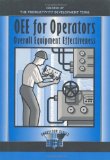OEE measures the overall efficiency of a production line or that of a whole facility. OEE makes a worthwhile improvement towards the productivity of a manufacturing unit. Implementation of software systems invariably benefits the OEE score by up to 20% in the first year. It has been proven that improving the Overall Equipment Effectiveness by just 1% produces a significant variation in the machine’s through put and savings in the unit cost of the produced items.
The OEE score is calculated from 3 elements: Availability, Performance and Quality. Availability equals the percentage of uptime of each manufacturing or plant asset. Performance equals the percentage throughput compared with the target set for it. Quality equals the percentage of scrap. To get the OEE score, multiply Availability by Performance by Quality.
OEE for Operators: Overall Equipment Effectiveness (Shopfloor Series)
Overall Equipment Effectiveness (OEE) is a crucial measure in TPM that reports on how well equipment is running. It factors three elements —the time the machine is actually running, the quantity of products the machine is turning out, and the quantity of good output – into a single combined score. Directly addressing those who are best positioned to track and improve the effectiveness of equipment, OEE for Operatorsdefines basic concepts and then provides a systematic explanation of how OEE should be applied to maximize a piece of equipment’s productivity and recognize when its efficiency is being compromised.
Features…
OEE for Operators: Overall Equipment Effectiveness (Shopfloor Series)
Overall Equipment Effectiveness is valuable as a key performance indicator for factory supervisors. Whist the principles of the formula are simple, it can be extremely, highly complicated to calculate in in a working factory. Hence, special OEE software packages are normally used to acquire the data from each element of the manufacturing process and make the OEE calculation quickly. Typically this software is of a modular structure to give it maximum flexibility and allow it to fit with existing plant and data capture facilities and enterprise resouce planning system.
After the data has been capture and analysed, it is only useful once converted into reports that are reliable. OEE software from the main vendors gives a selection of reports that can be customzed and analyzed to faciliate the user to uncover what he is focused on.
OEE is accepted as the corner stone of lean manufacturing. via continuous improvements a manufacturing plant can become more energy efficient, improve productivity and decrease departmental silo-mentality as well as uncover and control risk. All aspects of manufacturing must comprehend the principles and practice of OEE and how it relates to the lean manufacturing principles as a key force for productivity manufacturing now and in the future.
